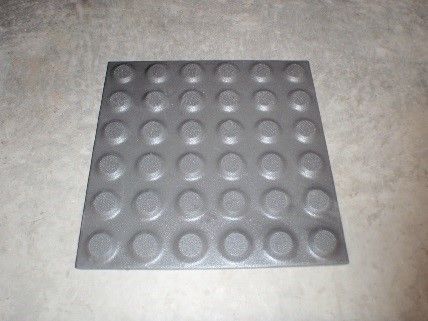What are TGSI’s?
Tactile Ground Surface Indicators (TGSI) are small dots or bumps that give visually impaired people information on hazards or obstacles in their immediate surroundings. TGSIs require to be slip resistant and to have a specific luminance contrast to the surrounding floor surfaces. The applicable Australian Standard for TGSI requirements is AS 1428.4.1-2009 Design for access and mobility – Tactile ground surface indicators for the orientation of people with vision impairment.
There are a couple of types of TGSIs used to give vision impaired persons information on hazards in the environment. Warning TGSI’s are used to warn of an impending danger such as stairs, ramps, escalators etc., they are circular domes, 35mm in diameter and 4-5mm in height. Directional TGSI’s direct the vision impaired person to a safe route, and are used at public transport access points and street crossings, they are long rounded rectangles, 35mm in width, 4-5mm in height and usually 300mm long.
Types of TGSIs
Warning and Directional TGSI’s can be further separated into three more categories, Integrated, Discreet and Composite Discreet. Integrated TGSI’s are ones that come with several as part of a product (e.g. Tile), Discreet TGSI’s come as individual ‘buttons’ that are all the same material (e.g. aluminium), Composite Discreet TGSI’s are discreet TGSI’s that have a different material on the top compared to the side (e.g. black non-slip top on an aluminium base).
Luminance Contrast Requirements
These three categories become important when selecting the TGSI that is right for the area of interest because each one is required by AS1428.4.1-2009 to have a different level of luminance contrast with its substrate. Integrated TGSI’s are required to have a 30% contrast, Discreet TGSI’s are required to have a 45% contrast and composite discrete TGSI’s are required to have a 60% contrast.
The luminance contrast required by AS1428.4.1-2009 shows that the choice of TGSI for the area has a big impact on if it will meet the required luminance contrast. The only way to tell if an installed surface meets the contrast requirements is to have luminance reflectance testing conducted, this can be done after installation or with sample pieces before installation.
For more information on luminance contrast testing, including tactile ground surface indicators, please contact the team at Safe Environments in Sydney or Melbourne.



